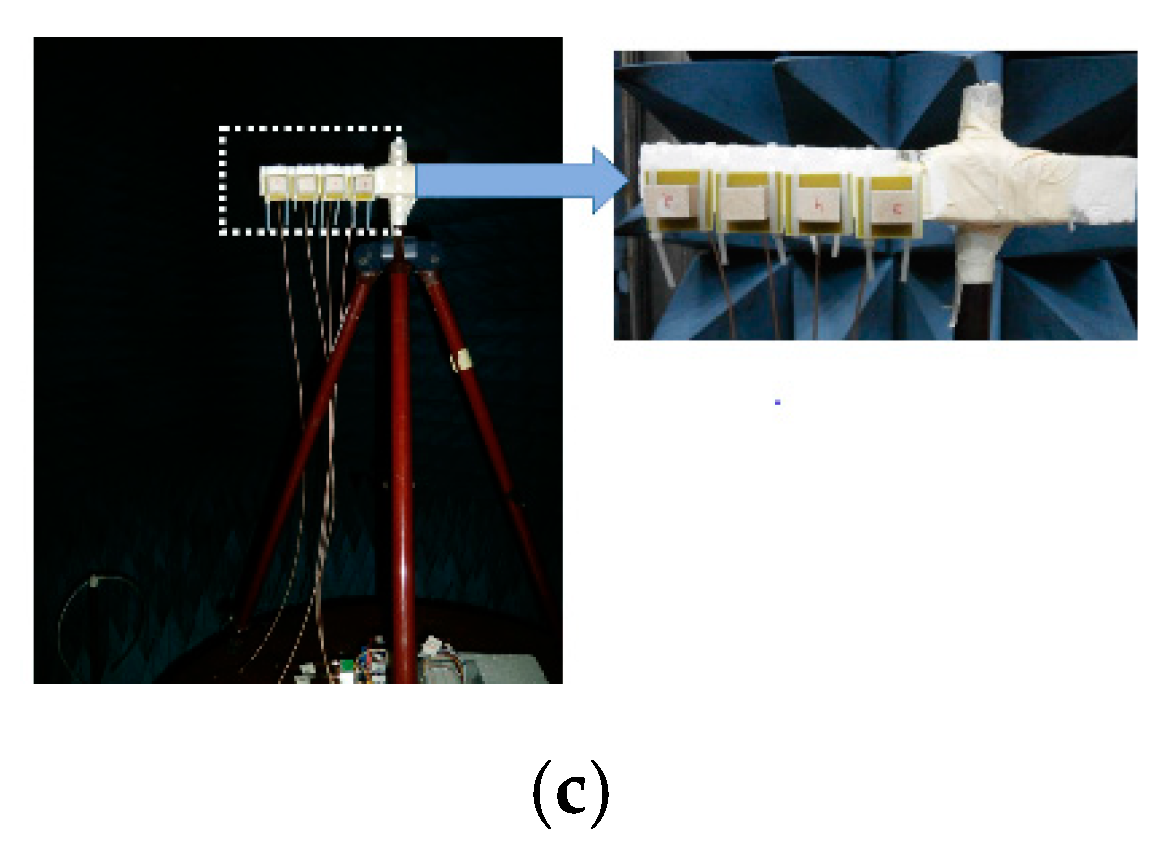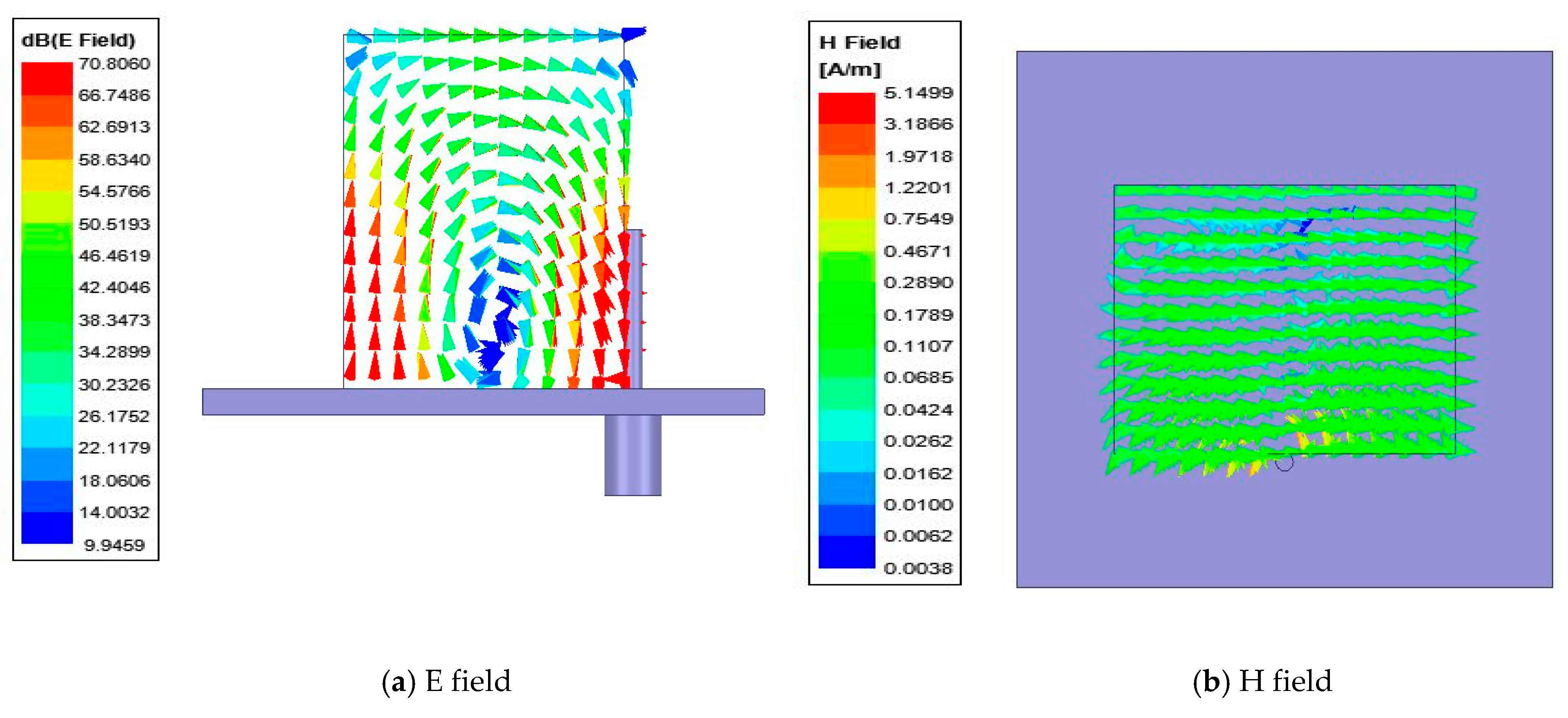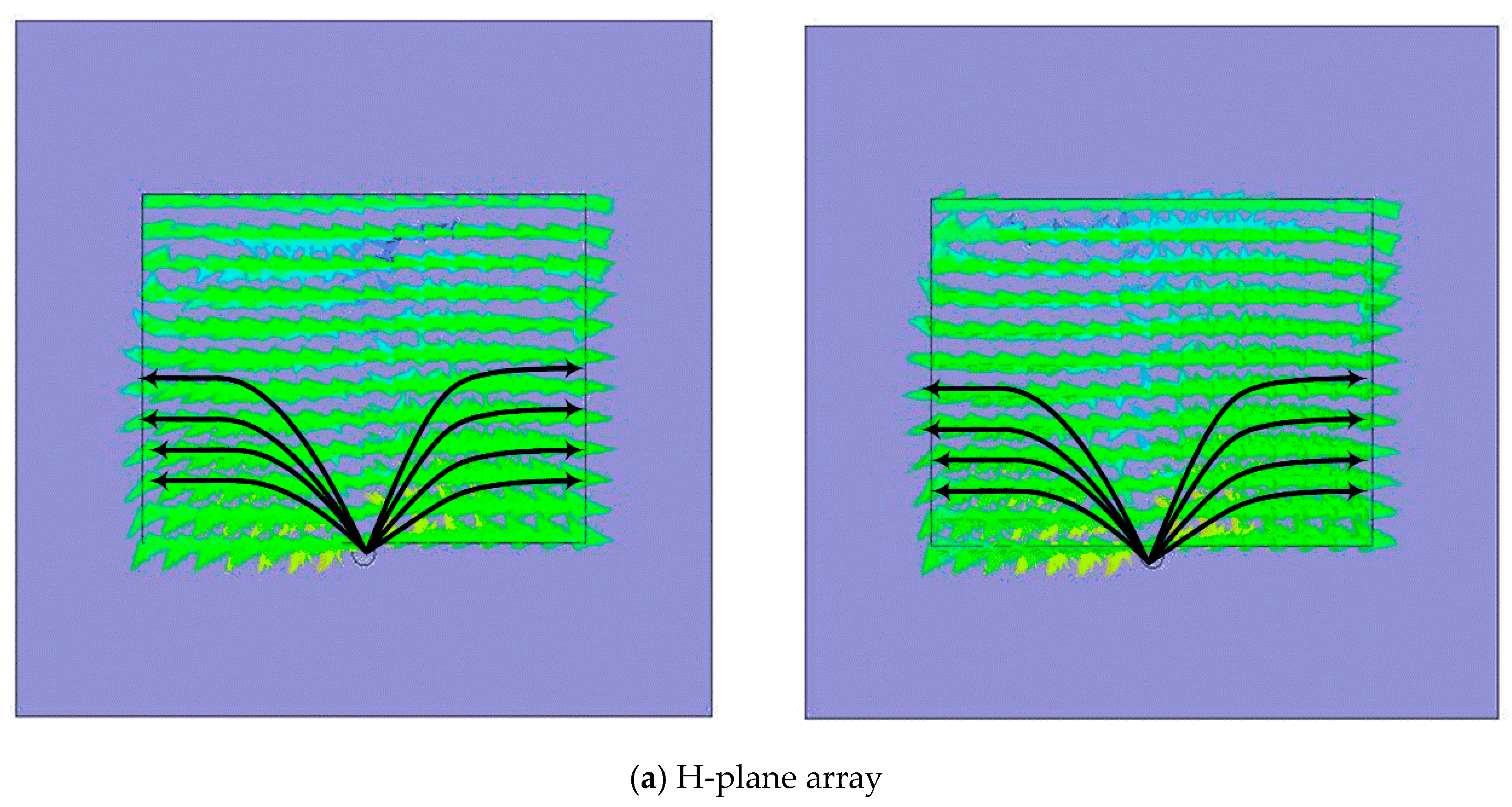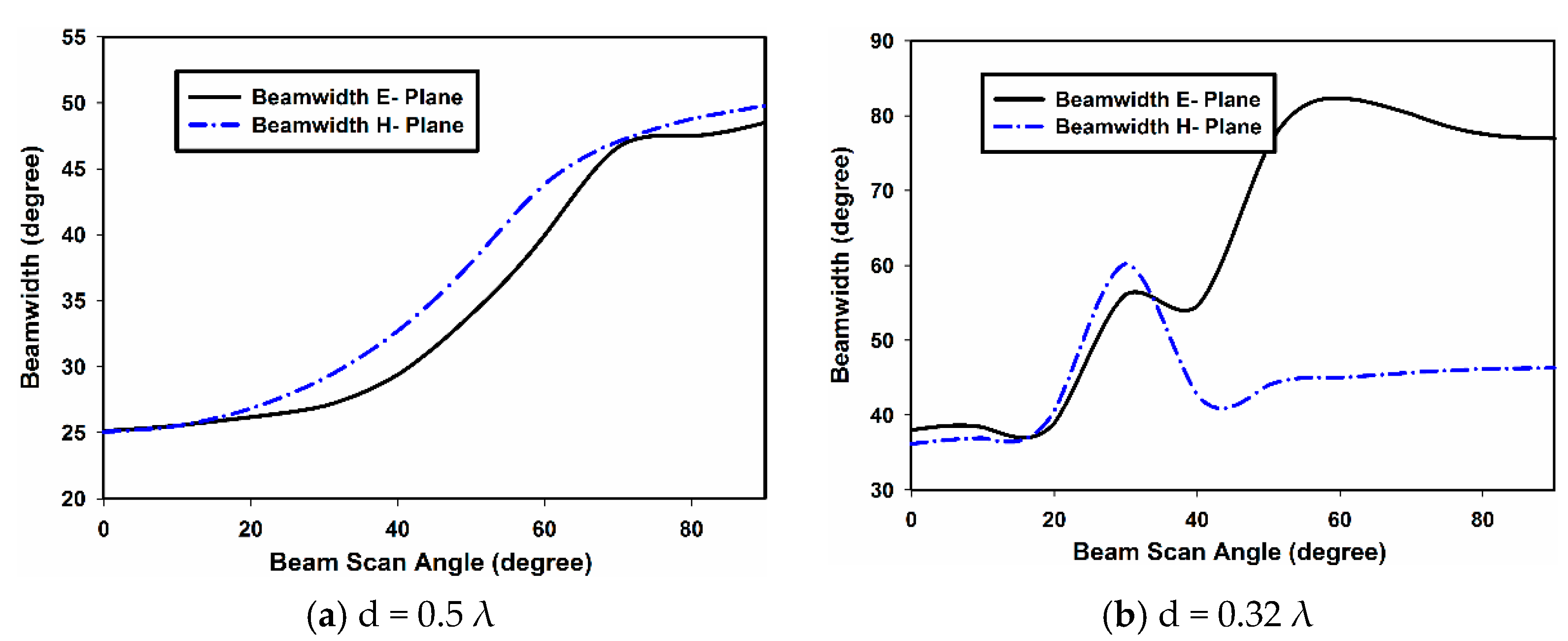Effects of Mutual Coupling on Gain and Beam Width of a Linear Array of a Dielectric Resonator Antenna for Main Beam Scanning Applications
Abstract
:1. Introduction
2. Main Beam Scanning of a 1 × 4 Linear RDRA
3. Measured Results and Discussion
3.1. S-Parameters
3.2. Radiation Patterns
3.3. Gain and Beam Width
4. Conclusions
Author Contributions
Funding
Conflicts of Interest
References
- Das, G.; Sharma, A.; Gangwar, R.K.; Sharawi, M. Compact Back to Back DRA Based Four Port MIMO Antenna System with Bi-directional Diversity. Electron. Lett. 2018, 54, 884–886. [Google Scholar] [CrossRef]
- Biswas, A.K.; Chakraborty, U. A compact single element dielectric resonator MIMO antenna with low mutual coupling. Frequenz 2021, 75, 201–209. [Google Scholar]
- Bahreini, B.; Oraizi, H.; Noori, N.; Fakhte, S. Design of a Circularly Polarized Parasitic Array with Slot-Coupled DRA with Improved Gain for the 5G Mobile System. IEEE Antennas Wirel. Propag. Lett. 2018, 17, 1802–1806. [Google Scholar] [CrossRef]
- Khan, S.; Ren, X.C.; Ali, H.; Tanougast, C.; Rauf, A.; Marwat, S.N.K.; Anjum, M.R. Reconfigurable Compact Wideband Circularly Polarised Dielectric Resonator Antenna for Wireless Applications. Comput. Mater. Contin. 2021, 68, 2095–2109. [Google Scholar] [CrossRef]
- Darimireddy, N.K.; Reddy, R.R.; Prasad, A.M. Tri-band and quad-band dual L-slot coupled circularly polarized dielectric resonator antennas. Int. J. RF Microw. Comput.-Aided Eng. 2018, 28, e21409. [Google Scholar] [CrossRef]
- Kshirsagar, P.; Gupta, S.; Mukherjee, B. A two-segment rectangular dielectric resonator antenna for ultra-wideband application. Electromagnetics 2018, 38, 20–33. [Google Scholar] [CrossRef]
- Gaya, A.; Jamaluddin, M.H.; Althuwayb, A.A. Ultra-Wideband Annular Ring Fed Rectangular Dielectric Resonator Antenna for Millimeter Wave 5G Applications. Comput. Mater. Contin. 2022, 71, 1331–1348. [Google Scholar]
- Petosa, A.; Ittipiboon, A. Dielectric resonator antennas: A historical review and the current state of the art. IEEE Antennas Propag. Mag. 2010, 52, 91–116. [Google Scholar] [CrossRef]
- Petosa, A. Dielectric Resonator Antenna Handbook; Artech House Publishers: Norwood, MA, USA, 2007. [Google Scholar]
- Gong, K.; Hu, X.H.; Hu, P.; Deng, B.J.; Tu, Y.C. A Series-Fed Linear Substrate-Integrated Dielectric Resonator Antenna Array for Millimeter-Wave Applications. Int. J. Antennas Propag. 2018, 2018, 9672790. [Google Scholar] [CrossRef]
- Nasir, J.; Jamaluddin, M.H.; Kamarudin, M.R.; Lo, Y.-C.; Selvaraju, R. A four-element linear dielectric resonator antenna array for beamforming applications with compensation of mutual coupling. IEEE Access 2016, 4, 6427–6437. [Google Scholar] [CrossRef]
- Jin, L.; Lee, R.; Robertson, I. A dielectric resonator antenna array using dielectric insular image guide. IEEE Trans. Antennas Propag. 2015, 63, 859–862. [Google Scholar] [CrossRef]
- Yin, Y.; Li, Q.; Chen, X. Wide-angle scanning phased array using wide-beamwidth dielectric resonator antenna with miniaturised radiator. Electron. Lett. 2022, 58, 182–184. [Google Scholar] [CrossRef]
- Qasaymeh, Y. Compact Interlaced Dual Circularly Polarized Sequentially Rotated Dielectric-Resonator Antenna Array. Comput. Mater. Contin. 2022, 72, 4631–4643. [Google Scholar] [CrossRef]
- Jedlicka, R.; Poe, M.; Carver, K. Measured mutual coupling between microstrip antennas. IEEE Trans. Antennas Propag. 1981, 29, 147–149. [Google Scholar] [CrossRef]
- Iqbal, A.; Nasir, J.; Qureshi, M.B.; Khan, A.A.; Rehman, J.U.; Rahman, H.U.; Fayyaz, M.A.; Nawaz, R. A CPW fed quad-port MIMO DRA for sub-6 GHz 5G applications. PLoS ONE 2022, 17, e0268867. [Google Scholar] [CrossRef] [PubMed]
- Guo, Y.-X.; Luk, K.-M.; Leung, K.-W. Mutual coupling between millimeter-wave dielectric-resonator antennas. IEEE Trans. Microw. Theory Tech. 1999, 47, 2164–2166. [Google Scholar]
- Junker, G.; Glisson, A.; Kishk, A. Mutual coupling effects and radiation characteristics of a linear array of dielectric resonator elements fed by coaxial probes. In Antennas and Propagation Society International Symposium, 1995. AP-S. Digest; IEEE: Piscataway, NJ, USA, 1995; pp. 1998–2001. [Google Scholar]
- Aras, M.; Rahim, M.; Rasin, Z.; Aziz, M.A. An array of dielectric resonator antenna for wireless application. In Proceedings of the 2008 IEEE International RF and Microwave Conference, Kuala Lumpur, Malaysia, 2–4 December 2008; pp. 459–463. [Google Scholar]
- Ling, X.; Li, R. A novel dual-band MIMO antenna array with low mutual coupling for portable wireless devices. Antennas Wirel. Propag. Lett. IEEE 2011, 10, 1039–1042. [Google Scholar] [CrossRef]
- Haupt, R.L. Antenna Arrays: A Computational Approach; John Wiley & Sons: Hoboken, NJ, USA, 2010. [Google Scholar]
- Jogunola, O.; Adebisi, B.; Hoang, K.V.; Tsado, Y.; Popoola, S.I.; Hammoudeh, M.; Nawaz, R. CBLSTM-AE: A Hybrid Deep Learning Framework for Predicting Energy Consumption. Energies 2022, 15, 810. [Google Scholar] [CrossRef]
















| S12 | S13 | S14 | S23 | S24 | |
|---|---|---|---|---|---|
| d = 0.5 λ | −28 | −28.7 | −28.6 | −29.6 | −28.7 |
| d = 0.32 λ | −10.2 | −16.9 | −13.79 | −25.4 | −16.9 |
| S12 | S13 | S14 | S23 | S24 | |
|---|---|---|---|---|---|
| d = 0.5 λ | −17 | −18 | −17.2 | −21 | −18 |
| d = 0.32 λ | −10.3 | −11.3 | −12.3 | −11.4 | −10.2 |
Publisher’s Note: MDPI stays neutral with regard to jurisdictional claims in published maps and institutional affiliations. |
© 2022 by the authors. Licensee MDPI, Basel, Switzerland. This article is an open access article distributed under the terms and conditions of the Creative Commons Attribution (CC BY) license (https://creativecommons.org/licenses/by/4.0/).
Share and Cite
Nasir, J.; Khan, A.A.; Khaliq, S.; Qureshi, M.B.; Ullah, I.; Liu, L.; Nawaz, R. Effects of Mutual Coupling on Gain and Beam Width of a Linear Array of a Dielectric Resonator Antenna for Main Beam Scanning Applications. Sensors 2022, 22, 6820. https://doi.org/10.3390/s22186820
Nasir J, Khan AA, Khaliq S, Qureshi MB, Ullah I, Liu L, Nawaz R. Effects of Mutual Coupling on Gain and Beam Width of a Linear Array of a Dielectric Resonator Antenna for Main Beam Scanning Applications. Sensors. 2022; 22(18):6820. https://doi.org/10.3390/s22186820
Chicago/Turabian StyleNasir, Jamal, Aftab Ahmad Khan, Shoaib Khaliq, Muhammad Bilal Qureshi, Irfan Ullah, Leo Liu, and Raheel Nawaz. 2022. "Effects of Mutual Coupling on Gain and Beam Width of a Linear Array of a Dielectric Resonator Antenna for Main Beam Scanning Applications" Sensors 22, no. 18: 6820. https://doi.org/10.3390/s22186820
APA StyleNasir, J., Khan, A. A., Khaliq, S., Qureshi, M. B., Ullah, I., Liu, L., & Nawaz, R. (2022). Effects of Mutual Coupling on Gain and Beam Width of a Linear Array of a Dielectric Resonator Antenna for Main Beam Scanning Applications. Sensors, 22(18), 6820. https://doi.org/10.3390/s22186820







